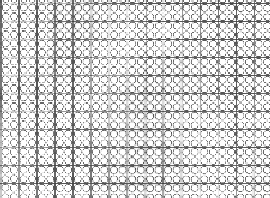Handbook Page 19
How to Make a Mark
Grid Marking
Electrochemical marking is a good way to evaluate sheet metal formability. See Grid Marking on our website. Knowing the level and distribution of strain in the critical areas of the stamping is the key with this technique. Grid patterns are ideally suited for this purpose.

Marking Grid
The first attempt to provide such measurements was the one inch scribed square test. This method for determining material specifications from a minimum number of blanks involves coating large blank areas with a blue dye, hand scribing the blank with one-inch squares, forming the blank, and using the maximum deformation in one square inch to establish steel requirements. For many stampings, however, a grid spacing of one inch is too large to measure strain distributions and peak strains accurately.
Furthermore, the squares are seldom oriented properly to indicate directly the maximum strain. Scribe markings are not only tedious in applications, but can also introduce stress concentrations as evidenced by breakage along scribe lines.
The circular grid system overcomes these limitations by using small diameter (1/5 to 1/10) circles as the grid patterns. The circles are small enough to detect point-to-point changes in the strain distributions and are non-directional for direct reading of maximum strain. Hand scribing of these fine grids is impractical and nearly impossible. Photo grids, ink stamps, silkscreen printing, and other surface printing techniques are useless because the grids are rubbed off during forming.
Only electrochemical marking can provide a rapid, yet permanent marking system capable of accurately reproducing the intricate pattern of circles.
The grid marking system utilizes a heavy-duty power source, a rocker electrode, and stencils covering a nine inch-by-nine-inch area. Stencils of patterns of different diameter circles are available. Larger areas can be marked by stepping the stencil along the blank. With this system, a blank can be gridded and made ready for press trials in several seconds. After forming, the distorted circles are measured and interpreted.
 Espanol
Espanol Française
Française